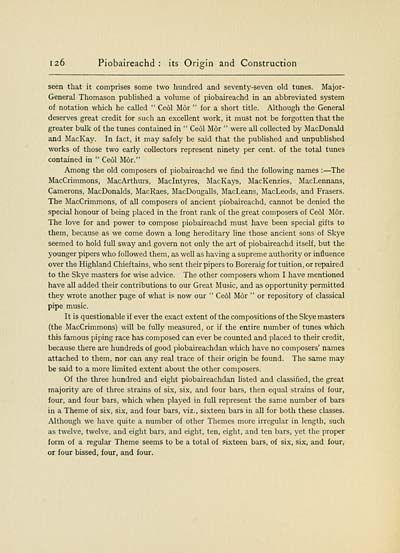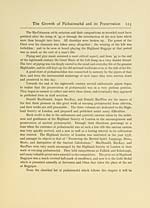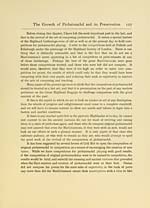Hew Morrison Collection > Piobaireachd
(132)
Download files
Complete book:
Individual page:
Thumbnail gallery: Grid view | List view

126 Piobaireachd : its Origin and Construction
seen that it comprises some two hundred and seventy-seven old tunes. Major-
General Thomason published a volume of piobaireachd in an abbreviated system
of notation which he called " Ceol M6r " for a short title. Although the General
deserves great credit for such an excellent work, it must not be forgotten that the
greater bulk o£ the tunes contained in " Ceol Mor " were all collected by MacDonald
and MacKay. In fact, it may safely be said that the published and unpublished
works of those two early collectors represent ninety per cent, of the total tunes
contained in " Ceol Mor."
Among the old composers of piobaireachd we find the following names : — The
MacCrimmons, MacArthurs, Maclntyres, MacKays, MacKenzies, MacLennans,
Camerons, MacDonalds, MacRaes, MacDougalls, Macleans, MacLeods, and Frasers.
The MacCrimmons, of all composers of ancient piobaireachd, cannot be denied the
special honour of being placed in the front rank of the great composers of Ceol Mor.
The love for and power to compose piobaireachd must have been special gifts to
them, because as we come down a long hereditary line those ancient sons of Skye
seemed to hold full sway and govern not only the art of piobaireachd itself, but the
j'ounger pipers who followed them, as well as having a supreme authority or influence
over the Highland Chieftains, who sent their pipers to Boreraig for tuition, or repaired
to the Skye masters for wise advice. The other composers whom I have mentioned
have all added their contributions to our Great Music, and as opportunity permitted
they wrote another page of what is now our " Ceol Mor " or repository of classical
pipe music.
It is questionable if ever the exact extent of the compositions of the Skye masters
(the MacCrimmons) will be fully measured, or if the entire number of tunes which
this famous piping race has composed can ever be counted and placed to their credit,
because there are hundreds of good piobaireachdan which have no composers' names
attached to them, nor can any real trace of their origin be found. The same may
be said to a more limited extent about the other composers.
Of the three hundred and eight piobaireachdan listed and classified, the great
majority are of three strains of si.\, six, and four bars, then equal strains of four,
four, and four bars, which when played in full represent the same number of bars
in a Theme of six, six, and four bars, viz., sixteen bars in all for both these classes.
Although we have quite a number of other Themes more irregular in length, such
as twelve, twelve, and eight bars, and eight, ten, eight, and ten bars, yet the proper
form of a regular Theme seems to be a total of sixteen bars, of six, six, and four,
or four bissed, four, and four.
seen that it comprises some two hundred and seventy-seven old tunes. Major-
General Thomason published a volume of piobaireachd in an abbreviated system
of notation which he called " Ceol M6r " for a short title. Although the General
deserves great credit for such an excellent work, it must not be forgotten that the
greater bulk o£ the tunes contained in " Ceol Mor " were all collected by MacDonald
and MacKay. In fact, it may safely be said that the published and unpublished
works of those two early collectors represent ninety per cent, of the total tunes
contained in " Ceol Mor."
Among the old composers of piobaireachd we find the following names : — The
MacCrimmons, MacArthurs, Maclntyres, MacKays, MacKenzies, MacLennans,
Camerons, MacDonalds, MacRaes, MacDougalls, Macleans, MacLeods, and Frasers.
The MacCrimmons, of all composers of ancient piobaireachd, cannot be denied the
special honour of being placed in the front rank of the great composers of Ceol Mor.
The love for and power to compose piobaireachd must have been special gifts to
them, because as we come down a long hereditary line those ancient sons of Skye
seemed to hold full sway and govern not only the art of piobaireachd itself, but the
j'ounger pipers who followed them, as well as having a supreme authority or influence
over the Highland Chieftains, who sent their pipers to Boreraig for tuition, or repaired
to the Skye masters for wise advice. The other composers whom I have mentioned
have all added their contributions to our Great Music, and as opportunity permitted
they wrote another page of what is now our " Ceol Mor " or repository of classical
pipe music.
It is questionable if ever the exact extent of the compositions of the Skye masters
(the MacCrimmons) will be fully measured, or if the entire number of tunes which
this famous piping race has composed can ever be counted and placed to their credit,
because there are hundreds of good piobaireachdan which have no composers' names
attached to them, nor can any real trace of their origin be found. The same may
be said to a more limited extent about the other composers.
Of the three hundred and eight piobaireachdan listed and classified, the great
majority are of three strains of si.\, six, and four bars, then equal strains of four,
four, and four bars, which when played in full represent the same number of bars
in a Theme of six, six, and four bars, viz., sixteen bars in all for both these classes.
Although we have quite a number of other Themes more irregular in length, such
as twelve, twelve, and eight bars, and eight, ten, eight, and ten bars, yet the proper
form of a regular Theme seems to be a total of sixteen bars, of six, six, and four,
or four bissed, four, and four.
Set display mode to: Large image | Transcription
Images and transcriptions on this page, including medium image downloads, may be used under the Creative Commons Attribution 4.0 International Licence unless otherwise stated. ![]()
| Early Gaelic Book Collections > Hew Morrison Collection > Piobaireachd > (132) |
|---|
| Permanent URL | https://digital.nls.uk/81165501 |
|---|
| Description | A selection of items from a collection of 320 volumes and 30 pamphlets of literary and religious works in Scottish Gaelic. From the personal library of Hew Morrison, the first City Librarian of Edinburgh. |
|---|
| Description | Selected items from five 'Special and Named Printed Collections'. Includes books in Gaelic and other Celtic languages, works about the Gaels, their languages, literature, culture and history. |
|---|

